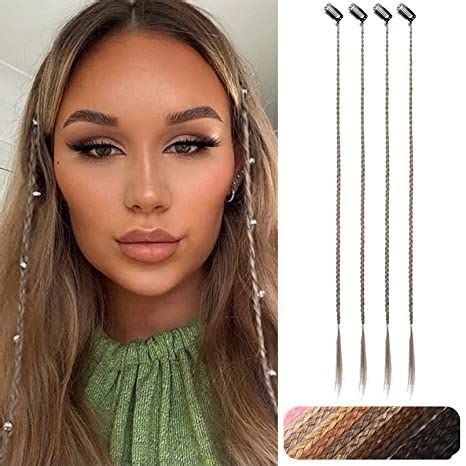Goodbye, Thin Hair Woes: How Hair Extensions Can Transform Your Look
Thin hair can be a frustrating problem, but it doesn’t have to be a permanent one. With the right hair extensions, you can add volume, length, and fullness to your hair, giving you the luscious locks you’ve always wanted.

Why Hair Extensions Matter
Thin hair affects millions of people worldwide, causing low self-esteem and embarrassment. It can be caused by genetics, aging, stress, or medical conditions. Hair extensions offer a non-invasive and effective solution to these problems:
- Boost Confidence: Full, voluminous hair can make you feel more confident and attractive.
- Hide Damage: Hair extensions can cover up damaged or thinning areas, giving you a more polished look.
- Versatile Styling: Extensions allow you to experiment with different hairstyles, from long and flowing to short and layered.
- Protective: Extensions can act as a shield against heat styling tools and environmental damage, promoting hair health.
Types of Hair Extensions for Thin Hair
There are various types of hair extensions available, each with its advantages and disadvantages:
1. Clip-in Extensions:
– Pros: Easy to apply and remove, providing instant volume.
– Cons: Visible clips, may slip or damage hair.
2. Tape-in Extensions:
– Pros: Flat and discreet, blend seamlessly with hair.
– Cons: Requires professional installation, can be time-consuming.
3. Bonded Extensions:
– Pros: Long-lasting, provides maximum volume.
– Cons: Requires heat or chemical bonding, can be damaging.
4. Weave Extensions:
– Pros: Strong and durable, can be customized for desired volume.
– Cons: Requires a skilled stylist to install, may put strain on hair.
5. Halo Extensions:
– Pros: Easy and comfortable to wear, adds instant volume without damage.
– Cons: Limited coverage, may shift or slide.
6. Micro Ring Extensions:
– Pros: Lightweight and natural-looking, minimal damage to hair.
– Cons: Requires professional installation, can be time-consuming.
7. Sew-in Extensions:
– Pros: Versatile and customizable, long-lasting.
– Cons: Requires a stylist for installation and removal, can cause tension on hair.
8. Ponytail Extensions:
– Pros: Adds length and volume to ponytails, easy to attach and remove.
– Cons: May not be suitable for short hair, can tangle.
9. Bang Extensions:
– Pros: Adds volume and style to bangs, quick and easy to apply.
– Cons: May not blend perfectly with natural hair, can be temporary.
10. Root Extensions:
– Pros: Conceals thinning hair at the roots, adds volume and thickness.
– Cons: Requires regular maintenance, may not blend perfectly.
How to Choose the Right Hair Extensions
Choosing the best hair extensions for thin hair depends on your individual needs and preferences. Consider factors such as:
- Desired Volume and Length
- Hair Type and Texture
- Budget and Maintenance Requirements
- Skill Level for Installation
Benefits of Hair Extensions for Thin Hair
- Increased Volume and Thickness: Extensions can instantly add volume and thickness to your hair, giving it a fuller appearance.
- Enhanced Length: Hair extensions can provide extra length, allowing you to experiment with different hairstyles.
- Improved Confidence: Thicker, fuller hair can boost your confidence and self-esteem.
- Versatile Styling Options: Extensions give you endless styling possibilities, from sleek and straight to bouncy curls.
- Protective Layer: Extensions can shield your natural hair from damage caused by heat styling and environmental factors.
How to Apply Hair Extensions at Home (for Clip-in and Tape-in)
Clip-in Extensions:
- Section your hair horizontally, clip in the bottom row of extensions first.
- Continue adding rows of extensions, blending them with your natural hair.
- Style as desired, and secure with bobby pins for extra hold.
Tape-in Extensions:
- Divide your hair into thin sections, placing a small piece of tape on the root of each section.
- Peel off the protective backing from the extension and press it firmly onto the tape.
- Repeat the process, ensuring the extensions are spaced evenly.
- Use a styling tool to create a desired look.
Maintenance Tips for Hair Extensions
- Brush extensions daily with a wide-tooth comb to prevent tangles.
- Wash extensions regularly with sulfate-free shampoo and conditioner.
- Use a heat protectant spray before blow-drying or styling with heat tools.
- Avoid over-conditioning, as it can weigh down extensions.
- Get regular professional maintenance to ensure extensions are secure and well-maintained.
FAQs about Hair Extensions
Q: Can I dye hair extensions?
A: Some hair extensions can be dyed, but it is recommended to consult a professional stylist to ensure they are compatible with the dye you wish to use.
Q: How long do hair extensions last?
A: The lifespan of hair extensions varies depending on the type, maintenance, and care. Clip-in extensions last a few months, while bonded extensions can last up to a year.
Q: Are hair extensions damaging to my hair?
A: Professional installation and proper maintenance can minimize damage. However, certain types of extensions, such as bonded or weave extensions, may put some strain on your natural hair.
Q: Can I wear hair extensions every day?
A: Yes, some hair extensions, such as clip-in or tape-in extensions, can be worn daily. However, it is important to give your hair a break from extensions occasionally to prevent excessive strain.
Q: What is the cost of hair extensions?
A: The cost of hair extensions varies widely depending on the type, length, and quality. You can expect to pay anywhere from $100 to over $1,000 for a full set.
- The Hair Extension Handbook: A Complete Guide to Types, Maintenance, and Styles
- American Hair Loss Association: Hair Extensions
- International Association of Trichologists: Hair Extensions
